
Whilst you might not be aware, the elements around us, light, magnetic fields and water, all have an impact on our biology. Scientists in Tokyo recently demonstrated this when they reported the effects of blue light on cells, causing them to fluoresce, and, what’s more, this fluorescence changed when a magnet was held over the cells.
Understanding the power of light to modulate cellular biology, it makes sense to harness all the good of visible light, without the damaging effects of UV radiation, which is exactly what LED light therapy allows us to do.
Since lockdown, the desire for home spa treatments has increased massively. Not surprisingly, the market has responded with a plethora of home treatment devices, including red light panels and LED light treatment masks, which has only increased its popularity further.
So, let’s take a deeper look at red LED light therapy as a modality for skin rejuvenation.
* This post contains some affiliate links. This means at no extra cost to you, I earn some commission if you purchase a product through my link. All thoughts are my own, though, as always. If you want to find out more, visit my affiliate disclosure page **
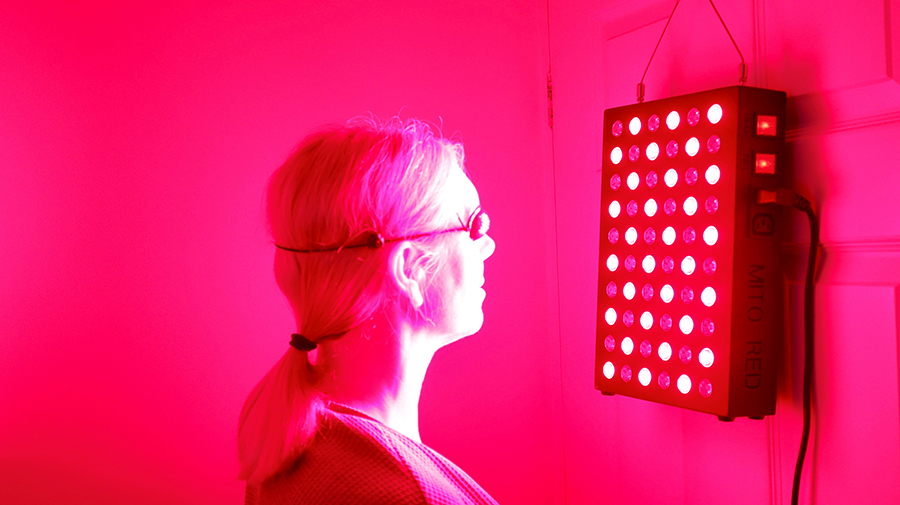
What is red light therapy?
Red light therapy, also known as photobiomodulation, is the use of visible LED light, without heat, to stimulate biological changes.
The effect of photobiomodulation was first reported by Endre Mester, a scientist in Budapest in 1967. Since then, over 6,000 papers have been published. Most of the literature reports the beneficial effects of red and near-infrared (NIR) LED light for promoting tissue healing and anti-inflammatory effects. This is light in the region of 600-1100 nm in wavelength.
If you are still sitting on the fence about red light therapy, then hopefully you will be better informed after this blog and might consider incorporating it into your skincare routine.
How does it work?
The literature suggests that red light and NIR are part of nature’s defence against UV light. Red light and NIR are high early in the morning and then high again in the afternoon, so they can offer a preparative and reparative action against UV light, which we know can be harmful to the skin.
Red light is anti-inflammatory and a biostimulator. It activates mitochondria, the organelles sometimes referred to as the batteries of our cells, because they are responsible for producing all the cell’s energy needs, in the form of a small molecule called adenosine triphosphate [ATP]. ATP drives all cellular processes from cell reproduction, and migration, to protein synthesis, which includes collagen synthesis. So, it’s not surprising that red light therapy has pro-ageing benefits.
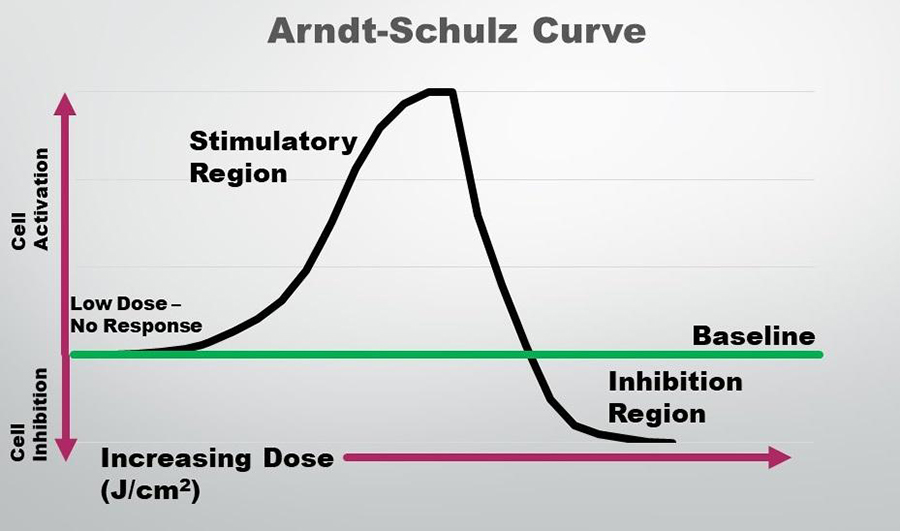
Limitations of red light therapy
When something positively impacts our health, it is all too easy to assume that you should do more of it. But that is not necessarily the case, and sometimes less is more!
In fact, it is not uncommon in nature for substances to give stimulating and beneficial effects at low levels, but, at high levels, they can have the reverse effect. With photo biomodulation, this biphasic dose response is often seen where low levels of light have a much better effect on stimulating and repairing tissues than higher levels of light.
Free radicals
The reason we see this effect with red light therapy is understood to be due to a build-up of free radicals. Initial exposure to red LED light delivers a burst of free radicals, which are an integral part of how red light therapy works.
But to quote the renowned photobiomodulation scientist, Dr Michael Hamblin: “Whether free radicals are beneficial or not depends on the levels.”
Low levels of free radicals are beneficial for cell heath because they act as signalling molecules to trigger biological processes, like cell division, cell migration and protein synthesis, including collagen production. Extended use of moderately intense LED light, however, can lead to a build-up of free radicals. Free radicals are unstable, reactive molecules, associated with ageing and disease. An excess of free radicals in the body will start to inhibit cellular processes and slow the efficiency of your red light device.
So how can we overcome this?
Well firstly, don’t overdo your red light therapy in a single session. If you are using an at-home device, be sure to stay within the recommended treatment time.
Secondly, you can combine topical antioxidants with your red light therapy treatment. Antioxidants are free radical scavengers. Cells have their own antioxidant defence mechanisms, but you can supplement these defence pathways with topical antioxidants.
Combination therapy
Combination therapy is the combination of two or more agents which have complementary actions to improve the outcome.
In this case, red light produces free radicals, and antioxidants fight free radicals. Combination therapy was first alluded to in a 2009 paper by Andrei Sommer and Dan Zhu.
Green tea and red light – a powerful duo in skin rejuvenation
The scientists reported that green tea antioxidants combined with LED Light accelerated the therapeutic effects of LED light therapy ten-fold! There are several other studies, which also report the benefit of antioxidants when used with photobiomodulation.
Green tea antioxidants
Whilst the science suggests that any antioxidant may give you an advantage when applied with red light therapy, it also supports that green tea antioxidants will give you a clear advantage. This is because of the target of the antioxidant.
Green tea is an excellent free radical scavenger, and it is particularly relevant in that it targets free radicals at the mitochondrial membrane, where they are produced by the action of your red light device.
Diagram
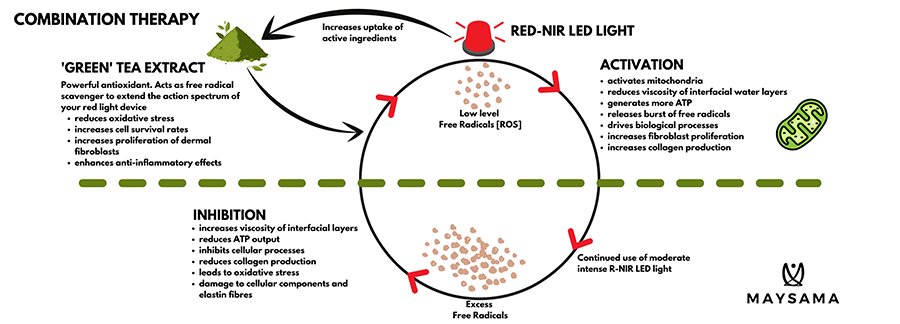
The cycle
We know that red light activates mitochondrial respiration, which increases the production of ATP, providing the energy for cell metabolism. This red light leads to an initial burst of free radicals, which act as signalling molecules to drive cellular processes, increasing the growth and reproduction of dermal fibroblast cells, which are responsible for producing collagen.
As red light irradiation continues though, free radicals start to build up. Under normal conditions, our cell’s natural antioxidant defence mechanisms, which include the enzyme superoxide dismutase, keep these free radicals in check. But if our antioxidant enzymes start to become overwhelmed, free radicals start to inhibit cellular processes and lead to a condition of oxidative stress. Prolonged oxidative stress can lead to cell damage and ultimately the cell will destroy itself through a kind of cell suicide. So, control of the level of free radicals is crucial to enjoy all of the benefits of your red light therapy and none of the downsides.
Green tea and green rooibos tea are superoxide dismutase mimetics, which means they mimic the action of superoxide dismutase and target the harmful superoxide free radical, acting at source, where free radicals are produced by the action of your LED light. Other antioxidants, like vitamin C [l-ascorbic acid] fight free radicals in other parts of the cell and so would not be so effective for this purpose.
Green rooibos tea

We know that green tea has a particular special relationship with red light therapy. But let’s talk about a special kind of green tea – green rooibos tea!
Unlike traditional green tea, which comes from the plant camelia sinensis and is native to China, green rooibos tea comes from the plant aspalathin linearis, which is native to South Africa. Many of you may know rooibos better as redbush tea. Unfortunately, the process used to make redbush tea destroys 90% of its antioxidant capacity.
Green rooibos tea, on the other hand, comes from the fresh leaves, which have not been oxidised, and so, like green tea, it has a high polyphenolic content and a corresponding high antioxidant capacity.
In dialogue with leading red light therapy scientist Andrei Sommer, he advised that it is very difficult to source green tea, even organic green tea, which is not contaminated with heavy metals from the soil, from farming practices used in India and China. But rooibos comes from South Africa. Sustainable farming techniques used in South Africa ensure more effective environmental pollution control than in China and India, leading to fewer contaminants and greater purity of raw materials. So green rooibos is potentially a purer form of green tea.
API Ingredient
We know that green rooibos has a higher antioxidant capacity than traditional rooibos. But what about Aspalathin-enriched green rooibos tea?
Aspalathin-enriched green rooibos extract is a unique phytopharmaceutical ingredient. It is used in the pharmaceutical industry to treat diabetes, and it is the hero ingredient in UK beauty skincare brand, Maysama.
Sourced from South Africa with sustainable farming methods, Maysama’s green rooibos tea extract undergoes patented extraction, which concentrates the main flavonoid, aspalathin, responsible for its antioxidant properties, making it 70 times more potent than standard rooibos tea.
Maysama’s Green Rooibos Pressed Serum is formulated with aspalathin-enriched green rooibos extract for potent antioxidant protection and loaded with humectants, which aid light penetration. Maysama’s Green Rooibos Pressed Serum is the perfect co-treatment with your red LED light therapy treatment.
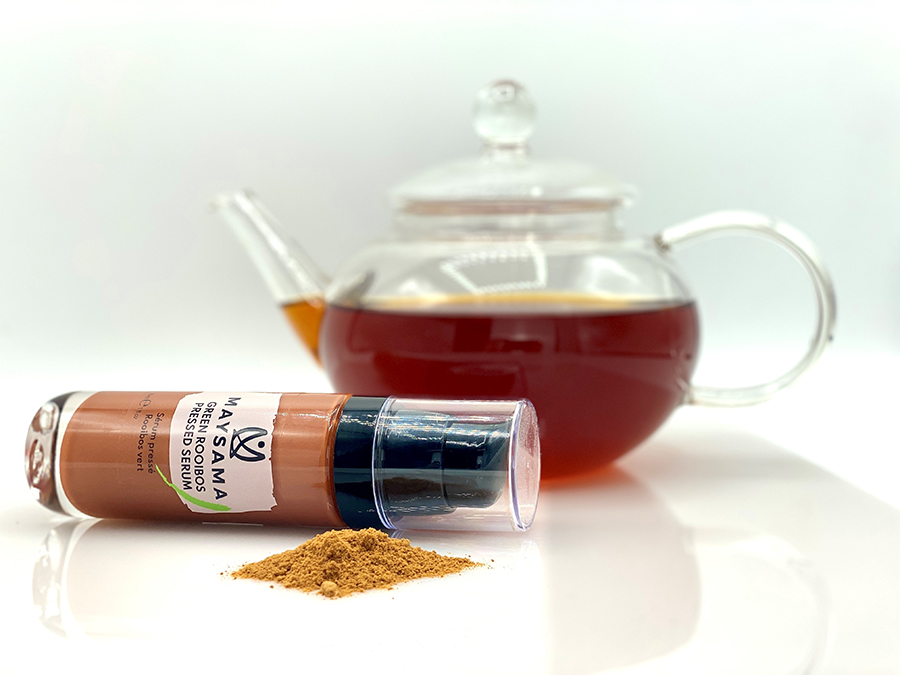
Extended product trials
Now I know you’re not going to take my word for it, so I’m sure you will be very interested to know that Maysama has run extended product tests combining Maysama Green Rooibos Pressed Serum with red-NIR LED light treatments to show that it improves results for skin rejuvenation over using LED treatments alone.
These product tests were carried out by a third-party independent regulatory laboratory and follow a strict procedure for claims testing.

The tests were carried out on a group of 16 women, aged 29-65. The serum was applied to split face (half face) 15 minutes before LED treatment. The LED treatment session was carried daily with a combined red and NIR Mito Red Light panel. The treatment session was for 10 minutes per day, repeated daily for a period of three continuous months. The results for various skin rejuvenation parameters were measured before and after 3 months.
Results
The results show an average of 260% improvement in outcomes for skin rejuvenation parameters, up and above using LED treatment alone.

As can be seen from the table above, topical application of Maysama’s Green Rooibos Serum prior to your LED light therapy treatment accelerates and amplifies the results for wrinkle reduction and improved elasticity, as well as helping to reduce pigmentation and redness (erythema).
Skin elasticity shows an increase of 20% after 3 months of LED treatments. But when used in combination with Maysama rooibos serum, skin elasticity increases by a massive 54%! Wrinkles are reduced by 10% with LED alone, and 29% with our serum + LED. Pigmentation is reduced by 9% with LED alone, compared to 23% with our serum + LED. And erythema is reduced by 13% with LED alone, compared to 30% when combined with our serum.
These tests confirm that Maysama’s potent antioxidant serum provides a significant advantage over using LED treatments alone and confirms, beyond doubt, that the buffering effect of topically applied green rooibos tea antioxidants extend the action spectrum of your LED device. The results to these extended product tests now allow Maysama Green Rooibos Pressed Serum to carry the claim: improves outcomes for LED.
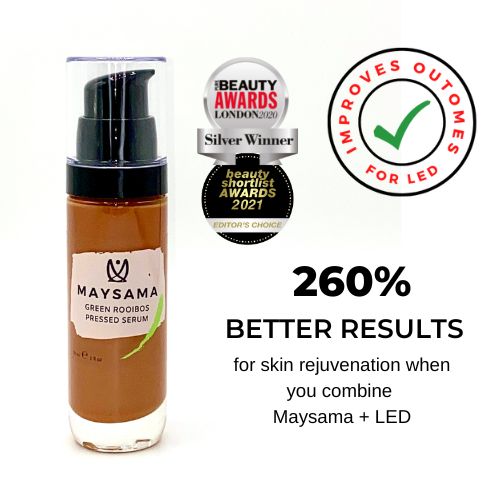
It is the only ‘green tea’ serum claims tested for this application.
Supercharge your red light therapy today with Maysama’s award-winning Green Rooibos Pressed Serum.
RRP: £46.00 or $62.95 for 30ml.
Enter coupon code SARAH10 at checkout to SAVE 10%. Shop here.


The results with the serum versus without are astonishing! I also love green tea as a scent, so I can definitely get behind this.
I had to throw away my Maysama Green Tea Serum because it was staining the gray hair around my face. It took many washings with a Clarifying shampoo to remove the brown staining. Can you recommend another brand to use with my red light therapy?